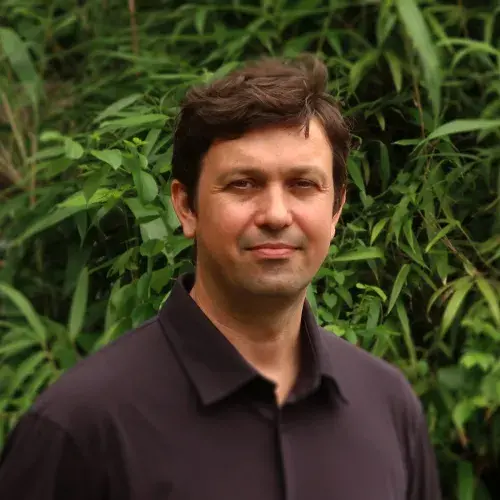
Professor, Art History and Visual Communication
Ph.D. Université Paris X
M.A. Université Paris X
B.A. Université Paris X
Office: Lowerre Academic Center, Office 15
Phone: +41 91 986 36 51
Email: ggee@fus.edu
Gabriel N. Gee holds a PhD in contemporary art history from the Université Paris 10 Nanterre. His doctoral research focused on aesthetics and politics in the North of England from the 1980s onwards. His book Art in the North of England. 1979-2008 was published by Ashgate (now Routledge) in 2017. He joined Franklin in 2011, where he teaches contemporary art history and theory. His research interests include the arts of port cities, interconnected global histories, and contemporary artistic research (member of the Swiss Artistic Research Network). He recently edited with Caroline Wiedmer a volume on Maritime Poetics. From Coast to Hinterland (Transcript 2021). He is the initiator and co-founder of the interdisciplinary study group TETI, (Textures and Experiences of Trans-Industriality), active through workshops, exhibitions, culinary events, and through a press, which recently published Mobile Soils a collection of essays looking at territorial transformations.
Publications:
Books:
Gee G. N & Wiedmer C. eds., Maritime Poetics: from coast to hinterland, Transcript Verlag, 2021.
Franchette, A.L., Jose Cacceres & Gee G.N, eds, Mobile Soils, Zurich: Teti Press, 2021
Gee G.N & Vogelaar A. eds, Changing representations of nature and the city: the 1960s -1970s and their legacies, London, New York: Routledge, 2018
Gee G.N., Art in the North of England. 1979-2008, London, New York, Routledge: an Ashgate book, 2017.
Book chapters:
Gee G.N, “Art in former military sites: spectres of geopolitics in the South China Sea”, in Edward Boyle & Steven Irving, eds., Heritage, contested sites, and border of memory in the Asia Pacific, Brill 2023.
Gee G.N. “The late 20th century marine: ‘forgotten spaces’ and trans-industrial visions”, in Terms, Comité International d’Histoire de l’Art, Beijing, 2021.
Gee G.N & Wiedmer C., “Introduction: Maritime introspections”, in Gee G. N & Wiedmer C. eds., Maritime Poetics: from coast to hinterland, Transcript Verlag, 2021.
Gee G.N, “Market Stall: The Representation of Trade in European Maritime Museums”, in Gee G. N & Wiedmer C. eds., Maritime Poetics: from coast to hinterland, Transcript Verlag, 2021.
Gee G.N. “Les navires de croisière entre narcissisime et passages de civilisations – 1880 - 1970”, in Christine Peltre, ed. Genèse de la croisière moderne. Les formes d’une expérience, entre loisir et découverte (1830-1970), Mare e Martin, 2020.
Gee G.N. “Beyond Narcissus: The metamorphosis of port cities in the 20th century”, in Gee G.N & Vogelaar A. eds, Changing representations of nature and the city: the 1960s -1970s and their legacies, Routledge, 2018
Gee G.N. “From stone to flesh: the deconstruction and reconstruction of the British monument” in Monument et modernité dans l’art et la littérature britanniques et américains, Marc Porée & Christine Savinel, eds, Paris, Presses Sorbonne Nouvelle, 2015.
Gee G.N, “Markers, borders, crossings: on the representation of a divided space in Northern Ireland”, in Claire Dubois & Vanessa Alayrac-Fielding (eds), The foreigness of foreigners: cultural representations of the Other in the British Isles (17th- 20th centuries), Cambridge Scholar, 2015
Gee. G.N. “Learning from the post-industrial transition in Northern England: alternative developments in the visual arts (1979-2008),” in Cultural Economies in Post-Industrial cities: Creating a (different) Scene, ed. Myrna Breitbart, Farnham, Ashgate, 2013.
Gee, G.N. “Art without Commerce in the North of England”, in Art and Commerce in the United Kingdom, Charlotte Gould & Sophie Mesplède (eds), Farnham: Ashgate, 2012.
Selected Articles:
Gee G.N, “Fragments: all so near”, in Terms of engagement, ThierryDufrêne & Peter Schneemann, eds., CIHA Journal n.1 (2023)
"Fragment. All to nah: patterns of fragments", in Terms of Engagement, CIHA Journal of Art History, n.1 (2023)
Mobile Soils, Anne-Laure Franchette, Gabriel N. Gee & Jose Caceres Mardones, eds., Zurich: TETI Press, 2021
Maritime Poetics. From Coast to Hinterland, Gabriel N.Gee & Caroline Wiedmer, eds., Transcript Verlag 2021
Gee G.N, “Painting within itself: the John Moores Liverpool Exhibition”, Journal of contemporary painting Issue 2, Vol.4, October 2018, pp.345-61
Gee G.N, “The metamorphosis of Cain: aesthetic in the trans-industrial city at the turn of the twenty-first century”, Visual Resources, Vol..4 October 2014
Gee G.N, “The catalogues of the Orchard Gallery: a contribution to critical and historical discourses in Northern Ireland, 1978-2003”, Journal of art historiography, n.9, 2013
Gee.G.N. “Malédiction et renaissance : lectures imagées de la ville du nord,” in Textimages, revue du dialogue texte-image, Varia 3, hiver 2013
Gee, G.N, “The representation of the northern city in the photography of John Davies (1981-2003)”, Visual Culture in Britain, Volume 11, Issue 2, December 2010.
Gee, G.N, “Valeurs instrumentales et valeurs de résistance dans l’art du Nord de l’Angleterre, 1979-2008” in Marges, “Valeurs de l’art”, Presses de l’université Paris VIII, n. 11, October 2010, pp. 76-80.
Gee G.N. “Négocier les ‘Troubles’, la Orchard Gallery à Derry, 1978-2003” in Textuels, revue Lettres, arts, cinéma, Presses de l’université Paris VII, September 2010.

